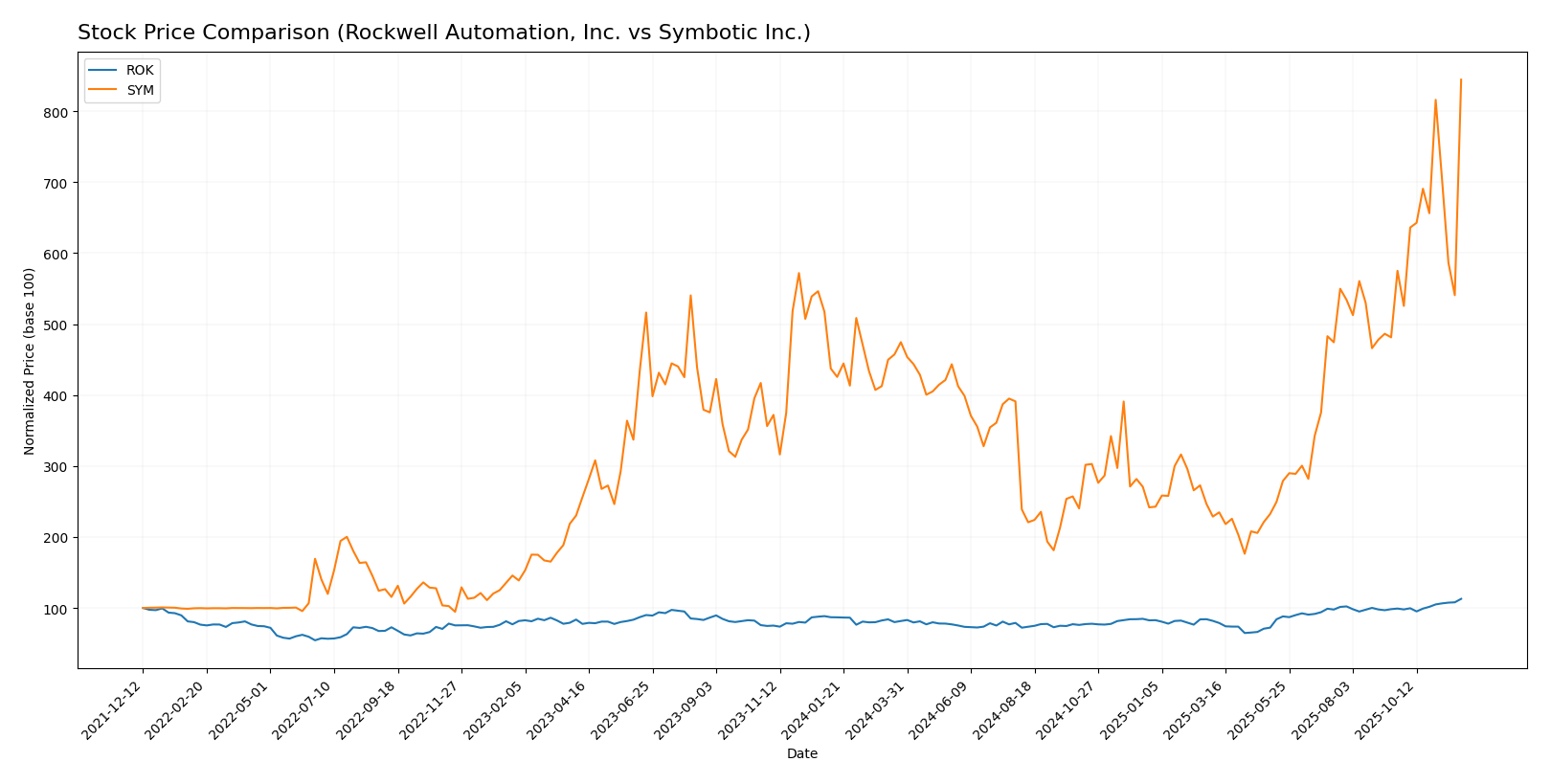In the rapidly evolving industrial sector, Rockwell Automation, Inc. (ROK) and Symbotic Inc. (SYM) stand out as key players, each utilizing innovative technologies to enhance operational efficiencies. While both companies operate within the industrial machinery industry, they address distinct market needs: Rockwell focuses on comprehensive automation solutions, whereas Symbotic specializes in warehouse robotics. This article will guide you in determining which of these two companies presents the most attractive investment opportunity.

Table of contents
Company Overview
Rockwell Automation, Inc. Overview
Rockwell Automation, Inc. is a leader in the industrial automation and digital transformation sectors, focusing on providing comprehensive solutions that enhance operational efficiency and productivity. Founded in 1903 and headquartered in Milwaukee, Wisconsin, Rockwell operates in three main segments: Intelligent Devices, Software & Control, and Lifecycle Services. Its diverse offerings include hardware like drives and motion products, as well as advanced software solutions for control, visualization, and cybersecurity. Serving various industries, from automotive to renewable energy, Rockwell leverages its extensive distribution network to provide tailored solutions that meet the unique demands of its clients. With a market cap of approximately $44.4B, Rockwell remains well-positioned to capitalize on the growing trend of automation and digitalization in manufacturing.
Symbotic Inc. Overview
Symbotic Inc., established in 2021 and based in Wilmington, Massachusetts, specializes in automation technology focused on enhancing supply chain efficiencies for retailers and wholesalers. The company is known for its innovative Symbotic System, a fully integrated warehouse automation solution that optimizes inventory management while minimizing operational costs. With a market cap of around $50.6B, Symbotic has rapidly established itself in the automation landscape, particularly in the logistics sector, where demand for efficiency and technology integration is soaring. The company aims to revolutionize the supply chain through robotics and intelligent systems, thereby contributing significantly to the future of warehousing.
Key similarities and differences
Both Rockwell Automation and Symbotic operate within the industrial machinery sector, emphasizing automation solutions. However, while Rockwell has a broader focus across various industries, including manufacturing and energy, Symbotic is primarily concentrated on supply chain automation for retailers and wholesalers. Furthermore, Rockwell has a longer history and a more extensive product portfolio, whereas Symbotic is a newer player with a specific niche offering.
Income Statement Comparison
The following table provides a comparative overview of the most recent income statements for Rockwell Automation, Inc. (ROK) and Symbotic Inc. (SYM), highlighting key financial metrics.
| Metric | Rockwell Automation, Inc. (ROK) | Symbotic Inc. (SYM) |
|---|---|---|
| Market Cap | 44.4B | 50.6B |
| Revenue | 8.34B | 2.25B |
| EBITDA | 1.40B | -75.4M |
| EBIT | 1.07B | -115M |
| Net Income | 869M | -80.6M |
| EPS | 7.69 | -0.16 |
| Fiscal Year | 2025 | 2025 |
Interpretation of Income Statement
In the most recent fiscal year, Rockwell Automation (ROK) demonstrated strong revenue growth at 8.34B, a slight increase compared to previous years. However, Symbotic (SYM) faced challenges, with a revenue of 2.25B, indicating a significant operational struggle reflected in its negative EBITDA and net income. ROK’s EBITDA margin remains robust, while SYM shows negative margins, indicating operational inefficiencies. The overall performance signifies ROK’s ability to maintain profitability and expand, while SYM’s financials suggest a need for strategic adjustments to improve operational efficiency and return to profitability.
Financial Ratios Comparison
The table below compares the most recent financial ratios for Rockwell Automation, Inc. (ROK) and Symbotic Inc. (SYM), providing insights into their financial health and performance.
| Metric | ROK | SYM |
|---|---|---|
| ROE | 0.27 | -0.17 |
| ROIC | 0.12 | -0.17 |
| P/E | 32.13 | -70.32 |
| P/B | 8.75 | 11.73 |
| Current Ratio | 2.37 | 1.09 |
| Quick Ratio | 1.56 | 1.00 |
| D/E | 0.97 | 0.00 |
| Debt-to-Assets | 0.36 | 0.00 |
| Interest Coverage | 8.37 | 0.00 |
| Asset Turnover | 0.74 | 0.94 |
| Fixed Asset Turnover | 6.89 | 19.10 |
| Payout Ratio | 0.60 | 0.00 |
| Dividend Yield | 1.87% | 0.00% |
Interpretation of Financial Ratios
Rockwell Automation exhibits solid financial health with a robust ROE of 27% and a comfortable current ratio of 2.37, indicating good liquidity. Conversely, Symbotic shows concerning metrics, particularly negative returns and a high P/E ratio indicating potential overvaluation. The absence of debt in SYM is positive, but its lack of profitability raises significant risks for investors.
Dividend and Shareholder Returns
Rockwell Automation (ROK) pays dividends with a current yield of approximately 1.87% and a payout ratio of about 60%. The company has a stable dividend history, although caution is warranted regarding its sustainability amid fluctuating profits. On the other hand, Symbotic Inc. (SYM) does not distribute dividends, reflecting its focus on reinvestment for growth during its high-growth phase. Both companies engage in share buyback programs, which may support shareholder value, but the effectiveness will depend on long-term operational performance.
Strategic Positioning
Rockwell Automation (ROK) and Symbotic Inc. (SYM) are key players in the industrial machinery sector, with ROK holding a market cap of $44.4B and SYM at $50.6B. ROK’s diverse offerings in automation and digital solutions position it well against competitive pressures, particularly from emerging technologies. In contrast, Symbotic focuses on warehouse automation, leveraging robotics to enhance operational efficiency. Both companies face technological disruption; however, ROK’s established market share offers a buffer against such challenges.
Stock Comparison
In analyzing the stock price movements of Rockwell Automation, Inc. (ROK) and Symbotic Inc. (SYM) over the past year, we observe significant price fluctuations and robust trading dynamics that reflect investor sentiment and market trends.

Trend Analysis
Rockwell Automation, Inc. (ROK) Over the past year, ROK experienced a price change of +29.77%, indicating a bullish trend. The stock reached a notable high of 395.86 and a low of 227.11, showcasing considerable volatility with a standard deviation of 36.69. The recent trend from September 14, 2025, to November 30, 2025, registered a price change of +14.77%, with a standard deviation of 17.78. This trend shows acceleration, further solidifying the positive outlook for ROK.
Symbotic Inc. (SYM) SYM demonstrated an impressive price change of +93.06% over the past year, classified as a bullish trend. The stock’s price varied from a low of 17.5 to a high of 83.77, accompanied by a standard deviation of 14.0, indicating stable volatility. From September 14, 2025, to November 30, 2025, SYM’s price surged by +75.43%, with a standard deviation of 10.52, also reflecting an acceleration in the upward movement.
Both companies exhibit strong bullish trends with notable price increases, suggesting a favorable environment for potential investors. However, it remains crucial to monitor market conditions and investor behavior to manage associated risks effectively.
Analyst Opinions
Recent analyst recommendations for Rockwell Automation, Inc. (ROK) indicate a cautious stance, with a rating of C- primarily due to low scores in return on equity and assets. Analysts suggest it may be a hold for now, given its limited growth potential. In contrast, Symbotic Inc. (SYM) has a slightly better rating of C, with some analysts recommending a hold, citing its potential for future growth despite current challenges. Overall, the consensus for both companies leans towards hold, signaling caution for investors in 2025.
Stock Grades
Recent stock ratings from reliable grading companies indicate the ongoing performance assessments for Rockwell Automation, Inc. (ROK) and Symbotic Inc. (SYM).
Rockwell Automation, Inc. Grades
| Grading Company | Action | New Grade | Date |
|---|---|---|---|
| Baird | maintain | Outperform | 2025-11-21 |
| B of A Securities | maintain | Buy | 2025-11-20 |
| JP Morgan | maintain | Neutral | 2025-11-11 |
| Morgan Stanley | maintain | Overweight | 2025-11-10 |
| Wells Fargo | maintain | Equal Weight | 2025-11-07 |
| Barclays | maintain | Overweight | 2025-11-07 |
| JP Morgan | maintain | Neutral | 2025-10-15 |
| Oppenheimer | maintain | Outperform | 2025-10-14 |
| Wells Fargo | maintain | Equal Weight | 2025-10-06 |
| Barclays | maintain | Overweight | 2025-08-14 |
Symbotic Inc. Grades
| Grading Company | Action | New Grade | Date |
|---|---|---|---|
| Barclays | maintain | Underweight | 2025-11-26 |
| Baird | maintain | Neutral | 2025-11-26 |
| Citigroup | maintain | Buy | 2025-11-25 |
| Northland Capital Markets | maintain | Outperform | 2025-11-25 |
| Cantor Fitzgerald | maintain | Overweight | 2025-11-25 |
| DA Davidson | maintain | Neutral | 2025-11-25 |
| Craig-Hallum | upgrade | Buy | 2025-11-25 |
| UBS | downgrade | Sell | 2025-09-23 |
| DA Davidson | downgrade | Neutral | 2025-08-25 |
| Needham | maintain | Buy | 2025-08-07 |
Overall, the trend for ROK shows consistent maintenance of positive grades, indicating a stable outlook from various analysts. Conversely, SYM displays a mix of upgrades and downgrades, suggesting a more volatile sentiment among investors.
Target Prices
The latest target consensus for Rockwell Automation, Inc. (ROK) and Symbotic Inc. (SYM) reflects optimistic expectations from analysts.
| Company | Target High | Target Low | Consensus |
|---|---|---|---|
| Rockwell Automation, Inc. | 402 | 345 | 377.6 |
| Symbotic Inc. | 83 | 41 | 67.38 |
For Rockwell Automation, the consensus target price of 377.6 is slightly below its current price of 395.86, indicating a modest expectation for price correction. In contrast, Symbotic’s target consensus of 67.38 suggests a potential upside from its current price of 83.77, aligning with a more positive outlook.
Strengths and Weaknesses
The following table outlines the strengths and weaknesses of Rockwell Automation, Inc. (ROK) and Symbotic Inc. (SYM) based on the most recent data.
| Criterion | Rockwell Automation, Inc. (ROK) | Symbotic Inc. (SYM) |
|---|---|---|
| Diversification | Strong across multiple sectors (industrial automation, software, services) | Limited, focused on warehouse automation |
| Profitability | Net profit margin: 15.26% (2023) | Negative net profit margin: -2.03% (2023) |
| Innovation | High investment in R&D, leading tech solutions | Emerging tech, but still developing full potential |
| Global presence | Operates in multiple countries | Primarily US-focused |
| Market Share | Significant in industrial automation | Growing, but smaller market share |
| Debt level | Debt-to-equity ratio: 1.17 | Zero debt, but high leverage on equity |
Key takeaways indicate that Rockwell Automation boasts strong profitability and diversification, while Symbotic is still developing its market presence and financial stability. Investors should weigh these factors against their risk tolerance.
Risk Analysis
Below is a summary of the primary risks associated with Rockwell Automation, Inc. (ROK) and Symbotic Inc. (SYM):
| Metric | Rockwell Automation, Inc. | Symbotic Inc. |
|---|---|---|
| Market Risk | Moderate | High |
| Regulatory Risk | Moderate | High |
| Operational Risk | Moderate | High |
| Environmental Risk | Low | Moderate |
| Geopolitical Risk | High | Moderate |
Both companies face significant market and regulatory risks, particularly in a rapidly evolving technological landscape. For instance, Symbotic’s recent operational struggles have resulted in negative profit margins, heightening its risk profile.
Which one to choose?
When comparing Rockwell Automation, Inc. (ROK) and Symbotic Inc. (SYM), the financial health and growth prospects differ significantly. ROK has demonstrated stable revenue generation, with an anticipated revenue of $8.34B and a net income of $869M, yielding a profit margin of approximately 10.42%. In contrast, SYM is struggling, forecasting negative profitability with a net income loss of $80.57M from revenues of $2.25B, leading to a negative profit margin. ROK’s stock trend is bullish, indicating positive momentum, while SYM shows a similar bullish trend but from a much lower base.
For growth-focused investors, SYM’s potential for rapid price appreciation could be appealing, whereas those prioritizing stability and profitability may prefer ROK. However, investors should be cautious about SYM’s financial instability and high valuation metrics.
Disclaimer: This article is not financial advice. Each investor is responsible for their own investment decisions.
Go further
I encourage you to read the complete analyses of Rockwell Automation, Inc. and Symbotic Inc. to enhance your investment decisions:



